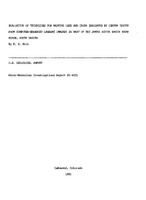The objective of this study was to evaluate remote sensing techniques for mapping irrigated crop types and acreages in part of the James River basin of South Dakota, using Landsat imagery. The results demonstrated that a subtraction (band 7 minus band 4) method was best for identifying the location of cropland irrigated by groundwater. Two separate principal-spectral-components analyses (analysis of the second principal-spectral component and the simultaneous analysis of the first three principal-spectral components) were best for identifying the crop type and estimating crop acreages. However, only 50 percent of the irrigated lands could be identified and only 79 percent of these could be classified accurately by crop type. Therefore, a 39 percent overall accuracy was achieved in irrigated crop-type identification. (USGS)


